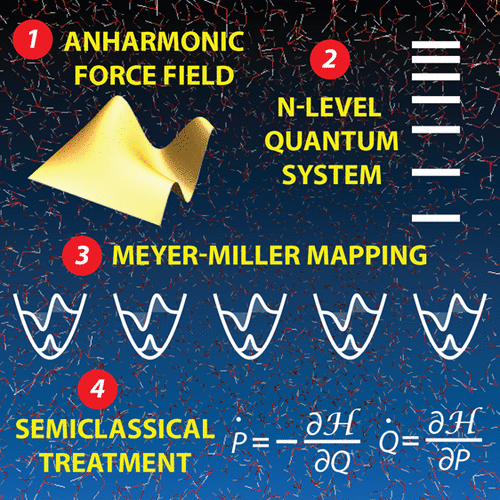当前位置:
X-MOL 学术
›
J. Phys. Chem. Lett.
›
论文详情
Our official English website, www.x-mol.net, welcomes your
feedback! (Note: you will need to create a separate account there.)
Nonadiabatic Dynamics via the Symmetrical Quasi-Classical Method in the Presence of Anharmonicity
The Journal of Physical Chemistry Letters ( IF 4.8 ) Pub Date : 2018-01-05 00:00:00 , DOI: 10.1021/acs.jpclett.7b03002 Alexei A. Kananenka 1 , Chang-Yu Hsieh 2, 3 , Jianshu Cao 2, 3 , Eitan Geva
The Journal of Physical Chemistry Letters ( IF 4.8 ) Pub Date : 2018-01-05 00:00:00 , DOI: 10.1021/acs.jpclett.7b03002 Alexei A. Kananenka 1 , Chang-Yu Hsieh 2, 3 , Jianshu Cao 2, 3 , Eitan Geva
Affiliation

|
The symmetrical quasi-classical (SQC) method recently proposed by Miller and Cotton allows one to simulate nonadiabatic dynamics based on an algorithm with classical-like scaling with respect to system size. This is made possible by casting the electronic degrees of freedom in terms of mapping variables that can be propagated in a classical-like manner. While SQC was shown to be rather accurate when applied to benchmark models with harmonic electronic potential energy surfaces, it was also found to become inaccurate and to suffer numerical instabilities when applied to anharmonic systems. In this paper, we propose an extended SQC (E-SQC) methodology for overcoming those discrepancies by describing the anharmonic nuclear modes, which are coupled to the electronic degrees of freedom, in terms of classical-like mapping variables. The accuracy of E-SQC relative to standard SQC is demonstrated on benchmark models with quartic and Morse potential energy surfaces.
中文翻译:

非对称存在下通过对称准经典方法的非绝热动力学
Miller和Cotton最近提出的对称准经典(SQC)方法允许基于基于系统大小的经典缩放比例的算法来模拟非绝热动力学。通过根据可以以经典方式传播的映射变量来转换电子自由度,可以实现这一点。尽管将SQC应用于带有谐波电子势能面的基准模型时相当准确,但也发现当应用于非谐系统时,SQC变得不准确且数值不稳定。在本文中,我们提出了一种扩展的SQC(E-SQC)方法,用于通过描述非谐核模式来克服这些差异,该非谐核模式根据经典映射变量与电子自由度耦合。
更新日期:2018-01-05
中文翻译:

非对称存在下通过对称准经典方法的非绝热动力学
Miller和Cotton最近提出的对称准经典(SQC)方法允许基于基于系统大小的经典缩放比例的算法来模拟非绝热动力学。通过根据可以以经典方式传播的映射变量来转换电子自由度,可以实现这一点。尽管将SQC应用于带有谐波电子势能面的基准模型时相当准确,但也发现当应用于非谐系统时,SQC变得不准确且数值不稳定。在本文中,我们提出了一种扩展的SQC(E-SQC)方法,用于通过描述非谐核模式来克服这些差异,该非谐核模式根据经典映射变量与电子自由度耦合。











































 京公网安备 11010802027423号
京公网安备 11010802027423号